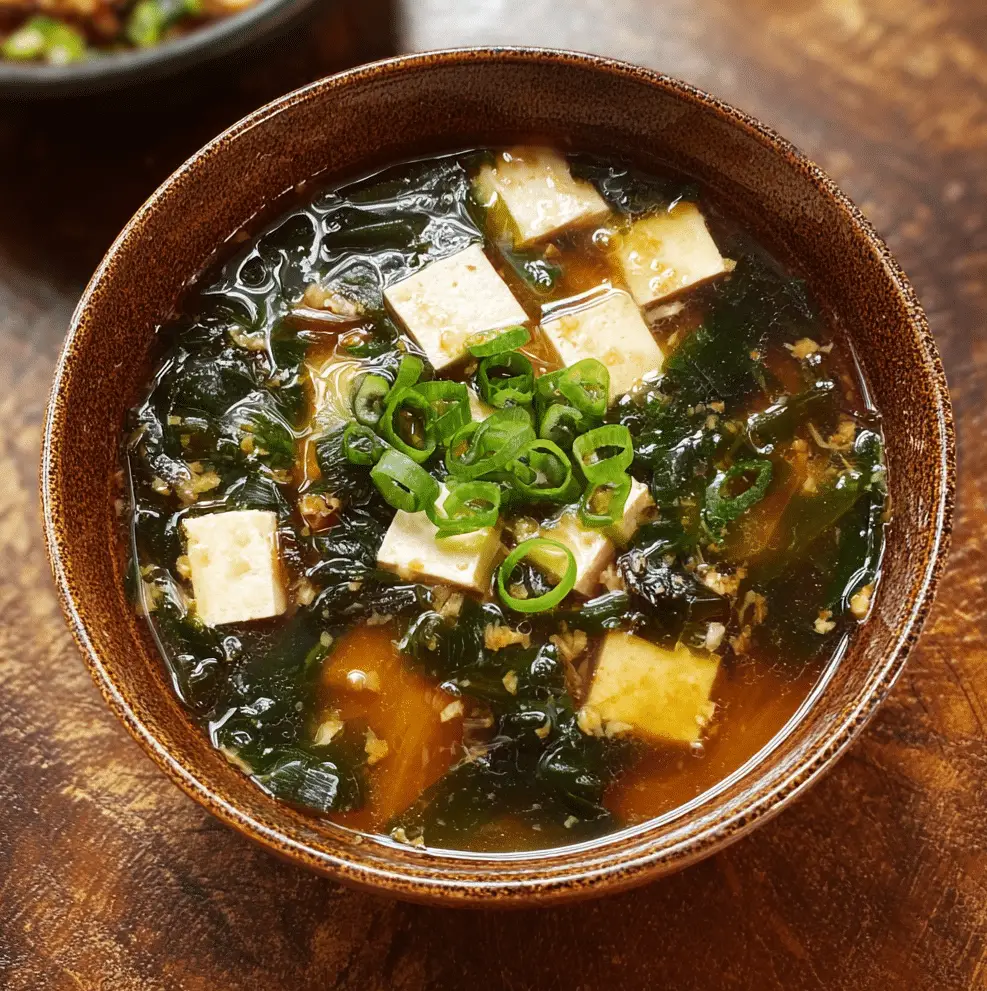The delicate flavors of this Miso Soup with Tofu bring a sense of calm and balance to your day. It’s a beautifully simple Japanese staple that’s rich in umami, deeply nourishing, and naturally low in calories. Whether you’re looking for a light starter or a comforting sip on a cold evening, this soup offers the perfect blend of warmth and wholesomeness.
It’s also incredibly quick to make—just 15 minutes from start to finish—and requires only a few pantry staples. With silky tofu, savory miso paste, and nutrient-packed wakame seaweed, this dish proves that simplicity in cooking can still be full of depth and satisfaction. Pair it with a bowl of rice or enjoy it solo for a refreshing and healthy meal.
Full Recipe
Ingredients:
-
4 cups dashi broth (or substitute with vegetable broth for vegetarian version)
-
3 tablespoons white miso paste
-
1/2 block silken tofu, cut into small cubes
-
1/4 cup chopped green onions (scallions)
-
1 tablespoon dried wakame seaweed
-
Optional: a small handful of enoki mushrooms or thinly sliced shiitake mushrooms
Directions:
-
In a medium pot, heat the dashi broth over medium heat until it’s hot but not boiling.
-
In a small bowl, mix the miso paste with a ladleful of the hot broth and stir until smooth.
-
Reduce the heat to low and gently stir the miso mixture back into the pot. Never boil miso, as it can affect the flavor and probiotics.
-
Add the cubed tofu and wakame seaweed. Let it heat through for about 2–3 minutes.
-
Add mushrooms if using, and cook for another minute until just tender.
-
Remove from heat and garnish with chopped green onions before serving.
Prep Time: 5 minutes | Cooking Time: 10 minutes | Total Time: 15 minutes
Kcal: 80 kcal | Servings: 2 servings
A Deep Dive into Miso Soup with Tofu: A Soulful Japanese Staple
Miso Soup with Tofu is more than just a dish—it’s a comforting, nourishing tradition that has been a cornerstone of Japanese cuisine for centuries. This humble soup may look simple, but behind its light and cloudy surface lies a complex depth of flavor that speaks volumes about the heritage and philosophy of Japanese cooking. Made with fermented miso paste, delicate silken tofu, and nutrient-rich seaweed, this dish reflects the principles of balance, umami, and minimalism.
The Cultural Significance of Miso Soup in Japan
In Japanese households, miso soup isn’t just a meal—it’s a ritual. It’s served at breakfast, lunch, and dinner, often accompanying rice, pickles, and a main dish. This deep integration into everyday life signifies the importance of health, harmony, and simplicity in Japanese food culture. Miso soup is so deeply woven into the fabric of the Japanese diet that it’s often said a day without miso soup feels incomplete.
Beyond being a comfort food, miso soup plays a symbolic role in Japanese cuisine. The act of preparing it daily connects people to their heritage and reminds them of the seasonal ingredients, natural fermentation processes, and the value of handmade food. Even in modern urban life, miso soup remains a constant, tying the past to the present.
Understanding the Umami Flavor
The term “umami” is now well-known globally, but it has long been central to Japanese cooking. Miso soup is one of the clearest examples of umami in action. The miso paste itself, made from fermented soybeans, delivers a rich, savory flavor that lingers on the palate. When combined with dashi—a broth typically made from kombu (kelp) and katsuobushi (bonito flakes)—you get a layered umami explosion that is both deep and comforting.
In vegetarian or vegan versions, the dashi is usually made with kombu and dried shiitake mushrooms, both of which are umami powerhouses on their own. This makes the soup incredibly satisfying even without the use of animal-based ingredients.
Tofu: A Plant-Based Protein Marvel
Silken tofu, used in traditional miso soup, is a gentle and smooth addition that subtly absorbs the surrounding flavors of the broth. Rich in plant-based protein, iron, and calcium, tofu makes miso soup a nourishing option for both vegetarians and meat-eaters alike. Because of its soft texture and mild taste, it’s perfect for soups—it doesn’t overpower the dish, but instead complements the broth beautifully.
Tofu also reflects the Japanese value of subtlety in food. It’s not about being bold or flashy, but about supporting the whole, much like how each ingredient in Japanese cuisine has a role to play in the balance of the final dish.
Wakame Seaweed: The Underrated Nutrient Powerhouse
One of the often-overlooked components of miso soup is wakame, a type of edible seaweed. Though used in small quantities, it adds a distinct flavor and texture, while delivering an impressive array of nutrients. Wakame is rich in iodine, calcium, magnesium, and omega-3 fatty acids, making it excellent for thyroid health and brain function.
As wakame rehydrates in the broth, it unfurls into soft, slippery green ribbons that are both beautiful to look at and satisfying to eat. Its addition contributes to the authenticity and health value of the soup, and for those who haven’t experienced seaweed in this form, it can be an eye-opening taste adventure.
The Health Benefits of Miso Soup with Tofu
Despite its simplicity, miso soup with tofu is packed with nutritional benefits. The fermentation process involved in making miso paste introduces probiotics into the diet, which are essential for gut health and digestion. Regular consumption of fermented foods is known to enhance immune function, improve nutrient absorption, and even support mental clarity.
Tofu adds protein and essential minerals, while wakame contributes fiber and antioxidants. When prepared with a good-quality broth, miso soup becomes a low-calorie yet satisfying meal that promotes overall well-being. It’s gluten-free, dairy-free, and can be easily adapted for vegan diets.
Additionally, many nutritionists recommend miso soup as a gentle detoxifying food. Because it’s hydrating, light on the stomach, and filled with gut-friendly bacteria, it can support liver function and improve digestion, especially when consumed regularly.
How This Dish Supports Mindful Eating
One of the reasons miso soup with tofu remains beloved is because it encourages mindfulness—both in preparation and consumption. The gentle simmering of broth, the quiet stirring of miso paste, and the careful placement of tofu cubes create a meditative cooking experience. Unlike fast food or heavy stews, miso soup invites you to slow down, savor each spoonful, and truly taste the harmony of ingredients.
In a world dominated by fast-paced lifestyles and ultra-processed foods, preparing miso soup becomes a small but significant act of self-care. It teaches us that nourishment doesn’t have to be complicated, and that even a simple bowl of soup can offer a moment of peace in a busy day.
Ways to Customize Miso Soup
One of the most appealing aspects of miso soup is its flexibility. While the classic version includes tofu and wakame, many people personalize their soup to suit the season or dietary needs. Add-ins can include:
-
Mushrooms (shiitake, enoki, or maitake)
-
Carrots or daikon radish (for extra sweetness and texture)
-
Spinach or bok choy
-
Rice noodles or soba for a heartier version
-
A dash of chili oil or grated ginger for a warming kick
The miso paste itself comes in different varieties: white (shiro), yellow (shinshu), and red (aka), each with its own flavor profile. White miso is sweeter and milder, ideal for daily soups. Red miso is more fermented and robust, best for deeper, wintertime flavors.
By mixing and matching these components, miso soup can evolve into dozens of different variations—yet still remain unmistakably authentic.
Why It Has Global Appeal Today
While miso soup was once mostly associated with Japanese meals or sushi restaurants, it’s now becoming popular worldwide. With a growing interest in plant-based, fermented, and gut-friendly foods, miso soup checks all the boxes for modern healthy eating trends. Its clean ingredient list, short cooking time, and versatility make it an ideal recipe for anyone looking to eat more whole foods without sacrificing flavor.
In home kitchens across the globe, cooks are discovering the satisfaction of mastering this simple yet soulful recipe. It’s not only affordable but also scalable—you can make a single portion or a large batch for the family. Even for beginners, miso soup is one of the easiest ways to explore Japanese cuisine and bring a sense of calm, nutrition, and flavor to the table.
Conclusion: The Beauty of Simplicity in Every Spoonful
Miso Soup with Tofu may be humble, but it carries with it generations of culinary wisdom. It exemplifies how a few basic ingredients—fermented paste, broth, tofu, and seaweed—can be transformed into something much greater than the sum of its parts. Its health benefits, soothing flavor, and cultural richness make it not just a dish, but an experience.
Whether you’re new to Japanese cooking or a lifelong fan, this soup deserves a place in your regular meal rotation. It’s quick to make, deeply nourishing, and endlessly adaptable. In a world of noise and excess, miso soup gently reminds us that beauty and wellness can often be found in simplicity.








